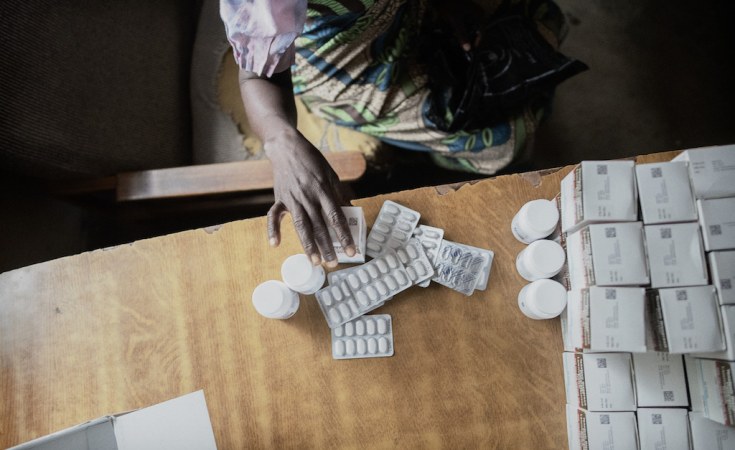In February 2021, findings from South Africa's first national tuberculosis (TB) prevalence survey confirmed what many suspected - every year, tens of thousands of people sick with TB are not diagnosed. It also confirmed that sub-clinical, or asymptomatic, TB disease is relatively common and that relying on people to present at clinics with symptoms won't do much to reduce TB transmission in the country.
In order to diagnose more people with TB more quickly, a new approach has been piloted whereby people thought to be at high risk of TB are offered the gold standard molecular tests even if they have no symptoms. In this 'targeted universal testing' (TUT) approach, people living with HIV, people who have had TB in the last two years, or household contacts of someone with TB are classified as being at high risk. A study Spotlight reported on in March 2021 suggested that the approach can substantially improve TB diagnosis and it indeed seems to have done so in the pilot projects.
In retrospect, it seems obvious. If we are failing to diagnose people in time or at all, then we should scale up testing.
Test and treat
That approach has now been taken a step further with what in a new set of TB guidelines is described as a test-and-treat approach. Test and treat is a concept mostly associated with HIV, where massive testing campaigns have resulted in over nine out of ten people living with HIV in the country knowing their status.
The new guidelines, titled 'National guidelines on the treatment of tuberculosis infection', envisage contacts of people with TB being offered molecular TB tests. If you test positive, you are offered TB treatment, if you test negative, you are offered TB preventive therapy. The 'treat' in this version of test and treat thus includes both treating active TB disease and 'treating' people at risk of TB with TB preventive therapy.
In retrospect, it seems obvious. If we are failing to diagnose people in time or at all, then we should scale up testing.
This is something of a simplification of the old system that often also involved testing for latent TB infection (a different test to the molecular test for active disease). The net is also thrown wider. In the past, only household contacts aged five or younger and people living with HIV were eligible for preventive therapy - now all contacts of someone with TB are eligible irrespective of age. There is an important recognition here that TB transmission takes place in many settings outside of the household, including schools, workplaces, correctional facilities, and, for that matter, healthcare facilities themselves.
In short, the new guidelines complement the TUT strategy with an ambitious expansion of eligibility for TB preventive therapy.
There is also good news in that, as more people become eligible for preventive therapy, many of them will be prescribed a new three-month course of preventive therapy called 3HP rather than the old six-month course. The switch to the new regimens may, however, not be as smooth as hoped. There are a few different regimens recommended in the guidelines and what people are offered will, in part, depend on what government can procure and what facilities have in stock. Nevertheless, the intent to switch to the new regimens is unequivocally a good thing. 3HP eligibility may be extended even further in coming years if research, much of which is led by South African researchers, into its use in specific groups such as young children and pregnant women, finds it to be safe.
In short, the new guidelines complement the TUT strategy with an ambitious expansion of eligibility for TB preventive therapy.
But what about implementation?
TB preventive therapy is nothing new in South Africa, but uptake has been far from optimal. The new guidelines may help address some barriers to uptake, but certainly not all. As Dr Adrienne Shapiro recently told Spotlight, "Clinic visits, particularly for ART (antiretroviral therapy) initiation, they're very busy. There's a lot going on and the priority of TB preventive therapy is often not as high as the priority for doing other things, especially starting ART."
Shapiro and colleagues recently found that in KwaZulu-Natal, a community-based rather than a clinic-based delivery model, dramatically increased uptake of TB preventive therapy. Implementation of the new guidelines will probably have to go hand-in-hand with such community-based care initiatives if it is to have the maximum impact.
One thing the new guidelines have going for them is that they will simplify rather than further complicate TB prevention efforts. As a rule, simplification should make successful implementation of any new guidelines more likely.
The new 'test and treat' approach also presents an opportunity to reframe TB prevention therapy from its position as a somewhat marginal part of our TB response to being absolutely integral. More broadly, together with other advances such as TUT and mobile X-ray screening, the new guidelines and test-and-treat approach present an opportunity to push South Africa's TB testing, treatment, and prevention efforts to the next level.
One thing the new guidelines have going for them is that they will simplify rather than further complicate TB prevention efforts.
But of course, the guidelines in themselves won't be enough. As we've often seen over the last decade, the chasm between a good national policy and what actually happens at healthcare facilities can be vast.
To live up to its potential, the new guidelines will have to be backed up not only by circulars and extra training but also by a public awareness campaign that has the full backing of the Minister of Health and the President. We have, after all, in the past seen similar HIV testing campaigns that have worked well. There is no reason we can't now do the same for TB. From a policy perspective, at least, many of the pieces are now in place.


